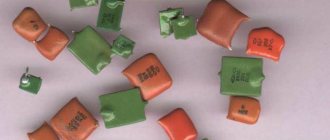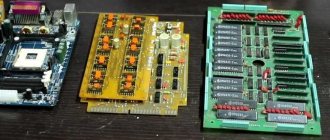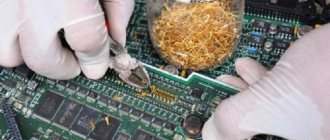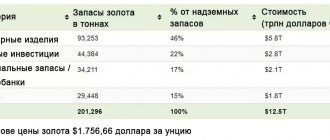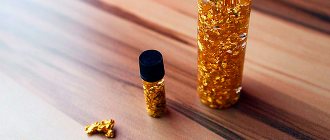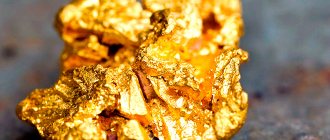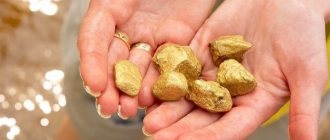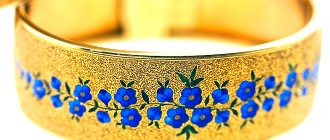Technical gold is gold that has not been purified to remove impurities. It cannot be used to make jewelry, as this is prohibited by law, but there are many other areas of its application.
Gold does not occur in nature in its pure form. Since it is widely used as jewelry, currency and raw materials, its reserves are depleting and demand is only increasing, due to the fact that it is a source of capital investment.
Gold from radio components
As you know, this metal is very soft and is not used in its pure form for the production of jewelry; as a rule, an alloy is used that contains 58 or 75 percent pure metal. Depending on the impurities, a wide variety of shades are obtained, including the most unusual ones - blue, purple, green. Products that are of a high standard and sold as jewelry are approved by the state assay office.
Applications of technical gold
But jewelry is not the only area of application for this precious metal. Gold is used in industry and is indispensable as a material for contacts in electronics. Despite the fact that technology has come a long way, it is still used in production. It was recently discovered that the average mobile phone contains about 25 milligrams of gold. It is applied to the contacts in its pure form using electroplating.
What’s interesting: this metal is used as targets for nuclear research, thanks to one of them, a little over a hundred years ago, Rutherford discovered a model of the atom. It also finds its application in a neutron bomb - it acts there as a coating.
Gilding of metals is used as a method of protection against corrosion. This coating of metals significantly reduces their disadvantages in the development and manufacture of equipment. It is in the production of electronics that the largest amount of this material is used. It is applied to circuit boards and parts in a thin layer, used as high-quality solder, and used to make conductors. In addition to good conductivity, gold has pronounced anti-corrosion properties, which makes it useful for use as a gasket.
Gold from microcircuits
In modern boards they are trying to use this metal less and less. Well, in this case it is replaced by palladium. Alloys of lead, tin or nickel are also suitable. Nevertheless, it will not be possible to completely abandon it for some time. Replacing with silver or platinum worsens the performance - over time, the metals oxidize.
Where is gold used?
Modern science does not stand still, and today you can find Au in the most unexpected industries. Few people know the fact that over the past 10 years, the amount of gold consumed by humanity has tripled.
Precious metal required:
- doctors and pharmacists;
- for car enthusiasts and astronauts;
- and also to all those who cannot imagine life without their favorite gadgets.
In medicine, Au is used as a material for the manufacture of hearing and ocular prostheses. The element is also included in the alloy from which medical instruments are made. Such accessories help reduce the risk of allergic reactions, as well as speed up the recovery process after surgery.
Pharmacists use gold to produce a whole range of medicines and cosmetics for skin, hair and body care. Au is used in the creation of medications that are used in the treatment of cancer tumors.
Car enthusiasts know that the precious metal is certainly present in the car; its use helps ensure safety and increase the speed of the car.
As for astronauts, if you believe the research, this industry spent about 40 kg on its needs over several years. A thin layer of metal is used to cover everything possible to protect contacts and even glass from corrosion. The glass on the astronaut's helmet is covered with a thin layer of Au, which helps protect the helmet from damage and exposure to environmental factors.
It is quite natural that today the largest amount of Au is found in modern gadgets. Smartphones, laptops, tablets and other wonders of modern technology attract those who like to extract Au from parts.
Many industries release new models of equipment so quickly that in just a year or two the equipment becomes completely obsolete. Even printers and scanners are designed for a certain number of operations, after which the equipment simply stops working, since it has a manufacturer’s code that blocks the operation of the equipment. If you crack the code, the scanner or printer will start working, but it’s easier and faster to buy a new one, rather than look for a specialist who will repair the equipment.
As an example, we can cite refrigerators and televisions that were manufactured back in Soviet times - they worked for decades and did not break. But today marketing dictates different conditions to us, and most equipment has a reserve, after which the equipment simply breaks down.
As a result, the amount of electronic waste is growing, and the need for recycling equipment and extracting precious metals is increasing. Not only factory workers, but also chemistry lovers take up the work. For those who have at least once extracted Au from microcircuit parts, it is clear that refining is a labor-intensive but quite interesting process.
Buying and selling
Unrefined gold can be purchased from people who extract precious metals from machinery. Why might it be needed? It can, for example, be used to apply decorative coatings or elements. To use it for jewelry purposes, the metal must be melted down, adding copper and silver to the alloy.
You can get this gold yourself. To do this, you need to master the technique of cleaning it. There are many ways to do this, but most of them use a substance called aqua regia. Aqua regia is a very strong solvent made by mixing hydrochloric and nitric acid. There are other methods, but most often one of the acids is still present there, so the procedure is unsafe.
What is the price per gram of this gold? Its cost rarely exceeds that set at a pawnshop. However, it is worth warning that buying and selling such gold is illegal.
Microcircuits containing gold
First of all, it is worth looking for gold in domestic radio components of the Soviet period - in imported ones the content of the precious metal is minimal. In many microcircuits, the gold is hidden under the copper casing. You can find out exactly the content of gold alloy in old microcircuits only by looking at the passport for this or that equipment.
Many microcircuits contain gold.
Gold is also found in round, ceramic, planar DIP microcircuits and transistors, plastic cases, and power transistors. In ALS indicators and diodes. In domestically produced connectors, pins with white or yellow coating of contact parts. In lamellas from boards. In ceramic monolithic capacitors of some brands, tantalum capacitors. In some switches, toggle switches, buttons, resistors. In rotation angle and pressure sensors. TPP and TPR thermocouples, thermal resistance, temperature sensors, strain gauges, pressure sensors. The installation wires have fluoroplastic insulation. In some generator lamps, in printed circuit boards with radioelements.
Much more gold is in Soviet computers. To achieve high performance, it was necessary to use a lot of precious metal. Most of these machines have been scrapped and replaced with modern and powerful ones, but such equipment is still found today and a decent amount of gold can be obtained from it.
List of precious metal content in old computers.
The easiest way to extract gold is from this technique. However, non-working equipment can be handed over to special collection points, which themselves sell it at their discretion and make a profit.
Among such equipment there may be a working one, but it is very expensive if offered to collectors.
Before proceeding directly to gold extraction, it is necessary to disassemble the device.
Sample of technical gold
From 1933 to 1974, gold was used in the production of microcircuits, connectors, capacitors and other equipment. This increased the characteristics of the devices, because gold, along with silver and platinum, has unique qualities, a high coefficient of thermal conductivity and electrical conductivity. Now manufacturers are trying to reduce the cost of equipment. And then, in times of total control, such a problem did not exist. This was especially true for military equipment.
Since 1975, the amount of gold in manufactured devices has decreased. This happened due to the fact that gold prices began to rise. In those days, most technical gold had a purity of 960-990. This is due to the fact that entire elements, such as connectors, were made from it. Now almost all gold in technology is pure, that is, it has a purity of 998-999, otherwise it cannot be applied by electroplating.
Mining technical gold from radio components is a profitable business, but subject to licensing. If you conduct an experiment on refining gold, it can be used for decorative purposes. A good alternative is to sell parts containing precious metals.
What is refining?
The widespread use of gold in industry has also led to negative consequences: there are fans of extracting metal from old microcircuits, that is, carrying out refining.
Refining is the process of obtaining pure precious metals by releasing them from a mixture. This method of obtaining gold from old electronics is also available at home.
How to carry out this refining? In words, everything is quite simple. If you read the reviews, you can understand that everything is not entirely simple. First, you need to find out which microcircuits contain gold.
Types and samples of gold
Yellow, white, red... And also green, pink, purple... How do these types of noble metal differ? What are the hallmarks of gold, which is better: 585 or 14 carats? What determines the price of a gram of gold? Which one is more profitable to buy? Moneyinformer.ru tries to give the most complete answers to these and other important questions for buyers of gold jewelry.
How are color and sample related?
Gold comes in different purities. This is its main characteristic and it is important to keep in mind first of all. Any gold product: coin, jewelry or bar can and usually contains impurities of other metals. The amount of natural gold in the product and the amount of impurities is reflected in the marking applied to it - the hallmark or hallmark. Samples vary in appearance and measuring system, but you can always find out from them what percentage of “pure” gold the product contains. (Of course, only if the information on it is reliable).
And the color depends on the type of additives in the gold alloy. It affects the price to a much lesser extent, with some exceptions (for example, in the case of white gold).
What determines the price of gold
When they talk about the cost of gold, they usually mean the price per 1 gram of pure metal on exchanges; it constantly changes depending on the situation in the financial and trading markets.
Since most gold products are an alloy of several metals, their “technical” price will be calculated strictly on the weight of pure gold included in the alloy. “Technical” refers to the price at which the product can be sold to buyers of precious metals, for example, pawn shops. The type of gold - whether it is yellow, or green, or purple - does not matter in this aspect. It goes without saying that the product may have artistic value, and then it may be able to sell for more. But this has nothing to do with the “technical” price. True, in rare cases, additives in the alloy themselves can be precious, for example, platinum, as sometimes happens with white gold.
Gold samples
The sample is applied to a gold product by the manufacturer and contains information about the percentage of pure precious metal Au in the alloy of which the product is made.
Nowadays, two systems are used to present information about the “purity” of a product: metric and carat. Metric is used in Russia and other CIS countries, carat is more often used in European countries and the USA.
The karat system for measuring gold in alloys should not be confused with the weight of precious stones - they even have different designations: “K” and “ct”. Thus, an 18-carat ring and an 18-carat diamond are completely different concepts, having in common only the fact that both belong to the jewelry industry.
It is very simple to understand the essence of the information reflected in the samples - it directly indicates the% of gold in the alloy. It's just that the metric system indicates this percentage directly in numerical terms (for example, 585 means 585 milligrams of gold per 1 gram of alloy), while the karat system assumes that the product is divided into 24 parts and tells us how many of these parts are natural gold. For example, the hallmark “12 carats” will tell us that the product consists exactly half of additional alloys and would correspond to the hallmark “500” if such was used in our country.
Table 1. Gold samples in carats and metric
| Carats (K) | 24 | 23 | 18 | 14 | 14 | 12 | 9 |
| Metric system (%) | 999 | 958 | 750 | 585 | 583 | 500 | 375 |
| Share of pure gold | 100-99,9% | 95,8% | 75% | 58,5% | 58,3% | 50% | 37,5% |
It is important to keep in mind that the hallmark (assay mark) in Russia, Ukraine, Belarus, Kazakhstan, the Baltic countries, and most other European countries is a sign of a state guarantee, indicating that the product has a hallmark not lower than the specified one and has been tested by the state assay inspection inspection for authenticity. However, gold jewelry and products sold in some other countries may have a hallmark that merely carries information from the manufacturer and is not a government guarantee.
Different colors of gold (or types of gold alloys)
The peculiarity of this yellow metal (this is its natural color), which is so often used by jewelers, is that it can take on different colors and shades depending on the ingredients with which it is mixed in the alloy. And its other feature is that it is very soft and impractical to wear. Therefore, it is difficult to do without additives in the manufacture of jewelry - the so-called “ligature” - in the jewelry business.
Yellow gold
This color will appear most clearly in those products where impurities are found in minimal quantities. The higher the purity of the product, the more pronounced yellow color it will have, as a rule and with rare exceptions. Accordingly, the price per 1 gram of such jewelry will be higher than that made from colored types of gold. True, as noted above, due to their relative softness they will be less practical to wear and less durable. For example, high-grade wedding rings tend to wear out and become thinner if women constantly wear them throughout their lives.
And gold coins and bars are always rich yellow, since there are practically no impurities in them, because their main purpose is to carry the price inherent in this metal.
White gold
The most common type of this gold alloy, which can be called classic or standard, is 58.5% gold, 21% copper, 7.84% zinc and 12.73% nickel. Nickel is more likely than other impurities to cause allergies, so it is sometimes replaced with manganese or palladium, or even platinum. To give products a better shine and increase durability, they are often coated with a thin layer of rhodium metal. The surface layer becomes more durable, which prevents scratches; but such products are no longer willingly accepted for purchase, since before they are melted down, the rhodium has to be cleaned off, and this is a labor-intensive process.
Platinum in white gold increases the value of the product. Some well-known brands sometimes produce elite series of products in which platinum occupies a larger percentage as a percentage. In the case of lesser-known manufacturers, the high platinum content in the product can only be declared.
Green gold
Green gold has been known since ancient times. This was often called electrum - a type of native gold, which is an alloy with silver. Natural electrum has a greenish tint, and the silver content usually prevails in it. Jewelry green gold has a more pronounced greenish color than the natural alloy, and the proportions of metals in it according to the most common standard are as follows: 73% gold and 27% silver. In Russia, you can most often find 750 green gold, but 585 is also found.
Previously, jewelers used other metals as alloys (additives to the alloy), such as cadmium. They did make the green color more pronounced, but they were found to be toxic or allergenic and their use is currently prohibited.
The price of green gold per gram is calculated in the usual way - based on the percentage of precious metal Au.
Rose and red gold
Gold takes on a reddish hue when mixed with copper. The more copper in the alloy, the more pronounced the tone of red. The most common standards:
– 75% gold and 25% copper for rose gold (750 or 18K)
— 50% gold and 50% copper for red gold (500 standard or 12K).
Rose and red gold are very popular among both jewelry manufacturers and their buyers. From these alloys it is possible to make jewelry that is complex in design and exquisite in beauty, which will be distinguished by strength and durability. And on top of that, the price per gram of rose gold may not be very high, thanks to the reduced pure gold content.
Rare colors
Sometimes jewelers, creating products of artistic quality, decide to use precious metal of even rarer shades. Thanks to admixtures, you can get very unusual colors, but some are used more often than others:
— Blue gold: 46% gold and 54% indium.
— Purple Gold : 80% gold, 20% aluminum.
— Black gold: 75% gold, 25% cobalt.
In what parts can you find gold?
Microcircuits. In them, gold is present in the form of gold-plated leads pressed into plastic or ceramic cases. The mass of gold leads is one third of the mass of the microcircuit. The gold content can vary from one to five percent.
Radio tubes
In them, gold is deposited on a grid located very close to the cathode. This is necessary so that the grid does not become a source of electrons.
Transistors
Gold is placed under conductors and crystals.
Don’t rush to throw away your old equipment - many of its parts contain gold.
Capacitors
Gold-bearing capacitors were used in military radio stations and generators. One capacitor measures up to forty centimeters in height and up to twenty centimeters in width. Such a capacitor contains up to seven grams of gold.
Resistors
Semiconductors, diodes, stabilizers, optocouplers, thyristors.
Connectors
Most older connectors can be gold plated.
